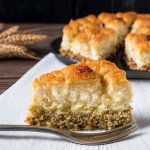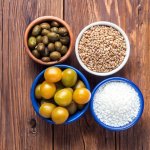voula_slat
Active member
I know that this isn't a traditionally Greek dish, just Greek inspired, but we have fun with it in my family.
You take a regular cheesecake recipe (the kind you have to bake), prepare it, and set it aside while prepping the baklava part.
Brush the cheesecake pan with better. Line it with a few sheets of phyllo - I eyeball it - and then brush it with butter. You want Mayne 3-4 layers of phyllo but make sure the pan is covered.
Prepare the nut filling of 2 cups ground nuts, 1/2 cup sugar, and about a teaspoon or more of cinnamon (I eyeball it) in a bowl. Sprinkle over the phyllo. Pour the cheesecake filling over it, and bake the cheesecake as directed in the recipe.
When about to serve, prepare a simple syrup with honey, water, sugar, orange zest, and honey. You'll need about a cup of syrup.

You take a regular cheesecake recipe (the kind you have to bake), prepare it, and set it aside while prepping the baklava part.
Brush the cheesecake pan with better. Line it with a few sheets of phyllo - I eyeball it - and then brush it with butter. You want Mayne 3-4 layers of phyllo but make sure the pan is covered.
Prepare the nut filling of 2 cups ground nuts, 1/2 cup sugar, and about a teaspoon or more of cinnamon (I eyeball it) in a bowl. Sprinkle over the phyllo. Pour the cheesecake filling over it, and bake the cheesecake as directed in the recipe.
When about to serve, prepare a simple syrup with honey, water, sugar, orange zest, and honey. You'll need about a cup of syrup.




